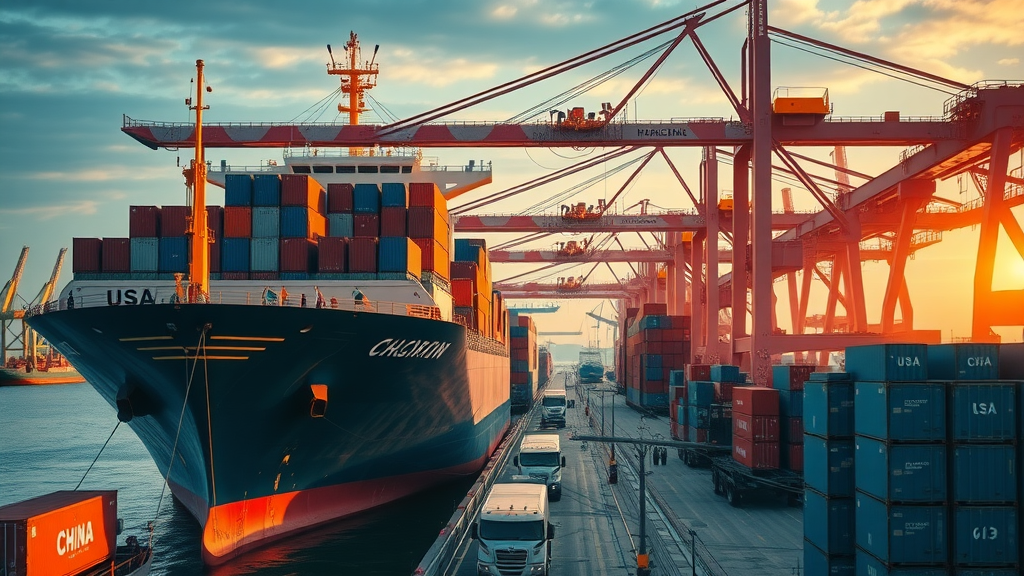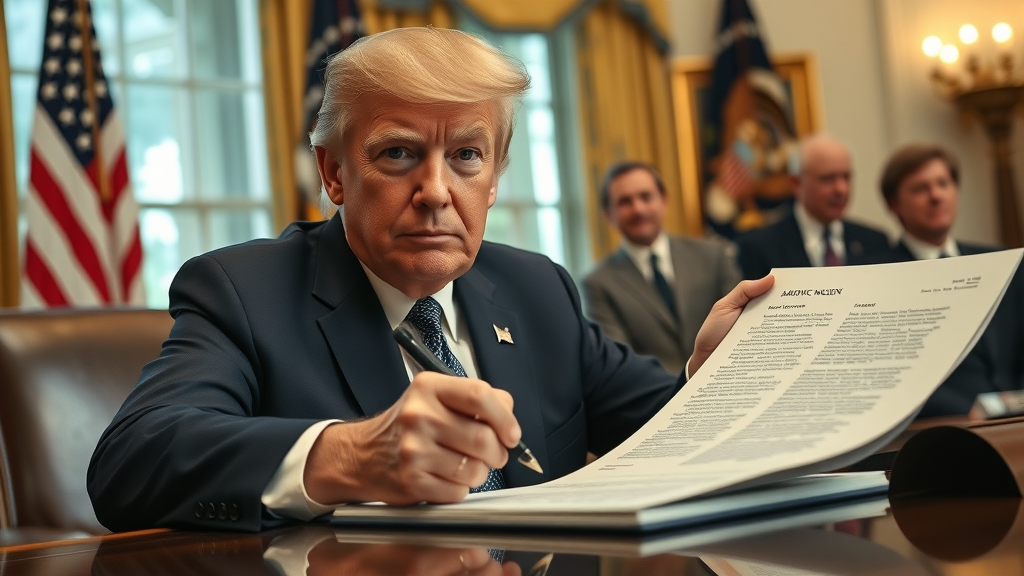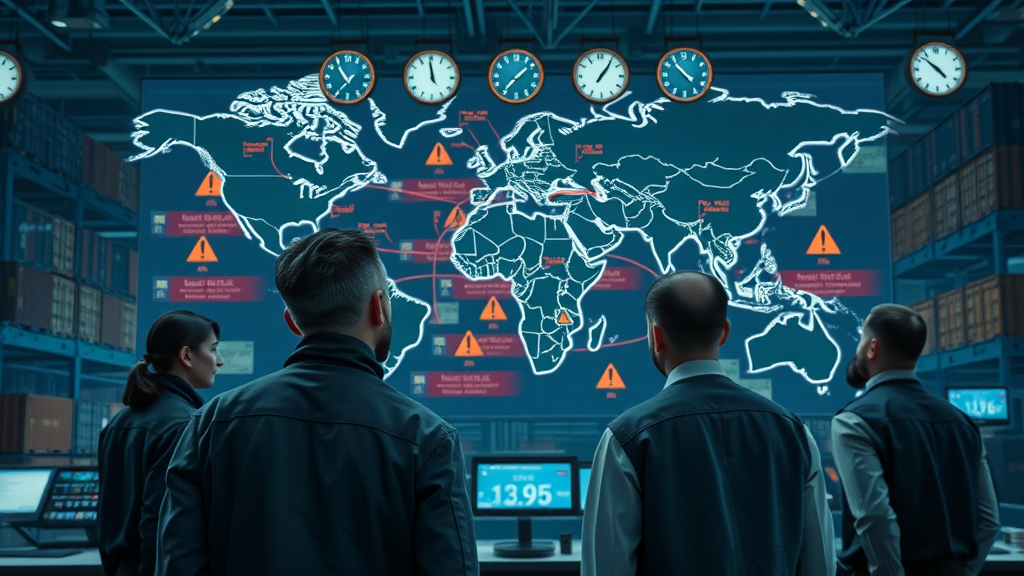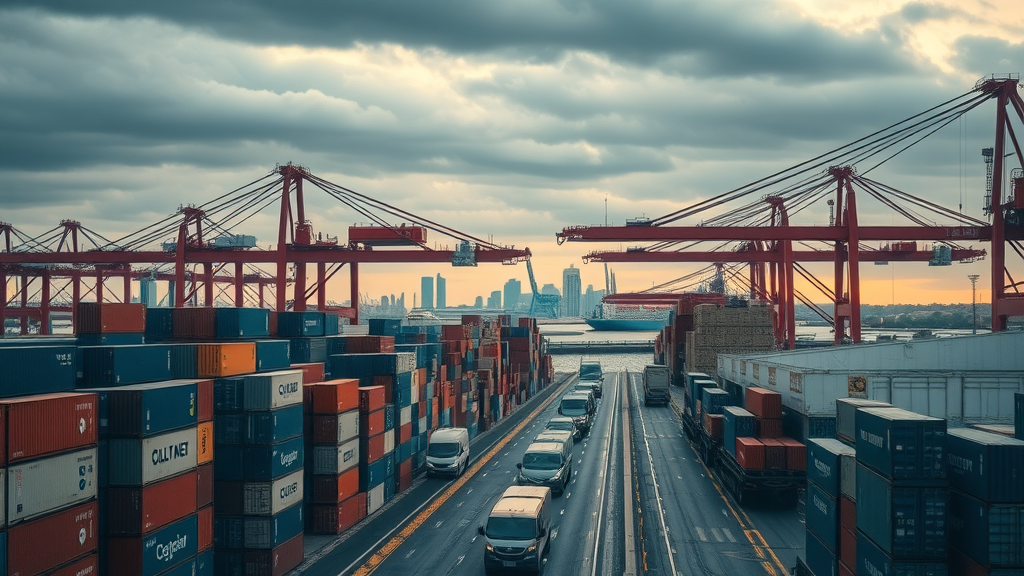Did you know trade war tariffs have cost American businesses more than $45 billion since 2018? As global supply chains are reshaped and political uncertainty mounts, companies in the United States, China, and beyond are feeling the bite of higher tariffs and increased volatility. If your business hasn’t yet mapped out a proactive defense, you could be putting your bottom line—and future growth—at serious risk. Now is the time to uncover the implications, dispel misconceptions, and plot a smarter path forward in a turbulent trade environment.

Trade War Tariffs: The Harsh Reality Behind the Headlines
The phrase trade war tariffs isn’t just a headline for the daily business section—it’s a financial force changing the way companies operate, plan, and survive. For many U.S. firms, these tariffs have meant higher import costs for component parts and finished goods, especially those sourced from China trade partners. As governments hike up tariff rates in pursuit of so-called fair trade or to rebalance trade deficits, the real-world consequences ripple from Wall Street to Main Street.
What does that mean day to day? Manufacturers may delay new product launches due to increased costs or shift supply chains to avoid hotspots like China. Retailers pass the costs onto consumers, leading to rising prices and uncertainty. Even if your business doesn’t import directly from China, retaliatory tariffs can indirectly impact pricing and availability throughout your distribution networks. Whether you’re a small exporter or a multinational with sprawling global operations, understanding these realities is no longer optional—it’s essential for staying competitive.
"Across industries, trade war tariffs have escalated costs for American businesses by over $45 billion since 2018."
How Trade War Tariffs Impact the United States and China Trade Environment
Since 2017, the United States-China trade war has altered the global economic landscape. The Trump administration’s aggressive stance on tariff rates targeted Chinese imports in an effort to deter what it called unfair trade practices . In response, China retaliated with their own tariffs, taking aim at key American exports like agricultural products and automobiles. This cycle of action and reaction has not only spiked costs for businesses relying on international suppliers, but has also injected new layers of risk into everyday operations.
In practical terms, U.S. companies now face tough choices balancing domestic sourcing with global competitiveness. Increased costs on critical inputs force budgetary overhauls, often at the expense of innovation or workforce investment. Meanwhile, Chinese businesses adjust by seeking alternative partners, investing in domestic supply, or pivoting to new export markets such as those in the European Union. As a result, the trade war tariffs drag on both sides, shrinking profit margins and reshaping the once predictable paths of international commerce.
| Year | United States (Average Tariff Rate on Chinese Goods) | China (Average Tariff Rate on U.S. Goods) |
|---|---|---|
| 2017 | 3.1% | 8.0% |
| 2018 | 12.0% | 16.5% |
| 2019 | 21.0% | 20.7% |
| 2020 | 19.3% | 20.0% |
| 2021 | 19.3% | 20.0% |
| 2022 | 19.3% | 20.0% |
| 2023 | 19.3% | 19.7% |
| 2024 | 19.0% (projected) | 19.5% (projected) |

Trade War Tariffs Explained: Definitions and Misconceptions
At their core, trade war tariffs are government-imposed taxes directed at goods imported from another country. The intent is often to protect domestic businesses, correct a trade deficit, or pressure countries to address unfair trade practices . However, misconceptions abound. Many believe punitive tariffs hit only foreign competitors, but the reality is that domestic businesses and consumers frequently shoulder the burden through higher costs and disrupted supply lines.
Another widespread misunderstanding is that tariffs always shift the economic advantage quickly back to the enforcing country. In reality, the global economy is deeply interconnected—tariff impositions on Chinese goods, for example, often trigger retaliatory tariffs on U.S. exports. The broader result is a shake-up in international trade flows, increased project uncertainty, and reduced economic growth. Clearing up these myths is crucial to understanding how, why, and where to react as policies change.
President Trump and the Rise of the Modern Trade War Tariffs
The surge in modern trade war tariffs can be largely traced back to the Trump administration . President Trump’s economic playbook placed a heavy emphasis on addressing the U.S. trade deficit with China and correcting what were seen as unfair trade practices by Beijing. This approach led to unprecedented levels of tariffs on Chinese goods, from electronics to raw materials, and forced American businesses into uncharted territory.
Beyond the direct U.S.-China standoff, the Trump administration’s actions had ripple effects, prompting both the European Union and other trading partners to reconsider their positions. New bilateral tensions surfaced, and global markets—already jittery from economic uncertainty—braced for aftershocks. The Trump team’s readiness to wield tariffs as a policy lever changed the global trade landscape in ways that continue to reverberate today, underscoring the necessity for businesses to stay vigilant and flexible as policies shift.
- The Trump administration's approach to tariff policy
- Key tariff rate shifts during the trade war
- Influence of retaliatory tariffs on American agriculture
- Pressure from the European Union amid China trade tensions

Retaliatory Tariffs: How They Threaten Global Supply Chains
As the United States leveled tariffs on Chinese imports , a rapid-fire sequence of retaliatory tariffs swept through the global marketplace. These retaliatory moves aren’t merely tit-for-tat—they redefine the way entire industries source materials, price products, and reach customers. For American companies, particularly those involved in agriculture, automotive, and technology, escalating tariffs often meant being boxed out of markets they’d spent years cultivating.
The domino effect drove up operational costs, delayed shipments, and forced sudden pivots in supply chain logistics. In parallel, overseas producers and logistics networks had to recalibrate routes and renegotiate supplier contracts, often at significant additional expense. The chain reaction doesn’t end at the border—a single set of retaliatory tariffs can disrupt a global economy deeply reliant on seamless cross-border trade.
For a deeper dive into actionable steps businesses can take to safeguard their profits amid ongoing tariff disputes, explore this comprehensive guide on how to protect your profits from trade war tariffs . It offers practical strategies tailored to the current global trade climate.
Case Studies: United States Businesses Facing Retaliatory Tariffs
Consider a Midwest soy farmer who had long shipped the majority of his crop to China. When retaliatory tariffs hit U.S. agricultural exports, his business faced a steep drop in foreign demand. Suddenly, warehouses filled with unsold grains, prices plunged, and the value of decades-long trade relationships evaporated overnight. Another example: high-tech manufacturers who import components from China encountered surging costs and had to make hard choices between raising prices, absorbing losses, or shifting operations altogether.
Even companies outside the direct line of fire—such as logistics firms or packaging suppliers—discovered indirect impacts as supply chains shifted and market uncertainty grew. In each case, the lesson is clear: no business is immune, and preparation is the only wise defense. The broader narrative remains one of ongoing adjustment and adaptation within a global economic system increasingly defined by unpredictability and protectionism.

China Trade Policies and the Escalation of Retaliatory Tariffs
China’s response to American tariffs was as strategic as it was swift. Rather than acting only in direct opposition, Chinese authorities implemented a mixture of tariff increases and targeted trade restrictions focused on U.S. goods with political and economic importance—like soybeans, pork, and automobiles. This approach served both to apply pressure to the Trump administration and to minimize collateral damage to their own domestic economy.
In addition to tariff responses, China pursued partnerships and trade agreements with other global trade partners, decreasing reliance on U.S. exports and investing in internal supply reshuffling. This not only transformed China’s role in the global supply chain but also forced American businesses to rethink where and how they export. Retaliatory tariffs, as China demonstrated, are rarely simple or short-lived—they can ignite enduring disruptions throughout the interconnected global marketplace.
"Retaliatory tariffs rarely lead to quick wins—they often spark long, drawn-out struggles impacting everyone from manufacturers to end consumers."
The European Union's Role in the Trade War Tariffs Dispute
The European Union has played a crucial balancing act in the current trade war tariffs saga. While not always the primary target or instigator, the EU has found itself drawn into the U.S.-China standoff. When the Trump administration increased tariffs—not only on Chinese goods but also threatened European products like steel and automobiles—the EU countered with its own suite of tariffs. This intricate web of actions and reactions underscores that the impact of the trade war isn’t just bilateral—it forces the broader global trading system to recalibrate.
Recognizing the risk to its own economic interests, the EU has focused on reinforcing multilateral trade agreements and pursuing dispute resolution through established frameworks like the World Trade Organization. Their measured response has helped buffer some economic shocks, but EU manufacturers and exporters remain on high alert, seeking to navigate a world in which tariff-related risks can spike overnight.
How the European Union Responded to US and China Trade War Tariffs
The EU’s response to escalating tariffs was strategic and, at times, assertive. By targeting American exports—such as bourbon, motorcycles, and agricultural goods—the European Union made clear it would defend its interests while maintaining dialogue with both Washington and Beijing. This approach helped the EU secure a seat at major trade talks and gave European businesses a chance to adapt to shifting global demand.
Over time, the EU has also invested heavily in diversifying trade portfolio, establishing new agreements with countries in Asia, South America, and within its own bloc to reduce vulnerability to future shocks. For U.S. companies, tracking the EU’s evolving policies is more important than ever—both as competitive threat and as a potential partner in less volatile times.
| Year | Country | Action | Targeted Products |
|---|---|---|---|
| 2018 | United States | Imposed new tariffs | Steel, aluminum, Chinese goods |
| 2018 | China | Retaliation | Soybeans, pork, automobiles |
| 2018 | European Union | Imposed retaliatory tariffs | Bourbon, motorcycles, agriculture |
| 2019 | China | Expanded tariffs | More U.S. agricultural and industrial goods |
| 2020 | United States | Tariff suspensions and adjustments | Medical supplies, certain electronics |
| 2022 | European Union | Calibrated tariffs and trade agreements | Defensive tariffs, trade alignment with Asia & Africa |
| 2023-2024 | Multiple | Renewed trade talks, some tariffs remain | Machinery, electronics, food products |

Unpacking the Meaning and Consequences of Trade Tariffs
To truly protect your business, you must understand not just what tariffs are, but what they mean on the ground. Trade tariffs , including those tied to trade war conflicts, are more than short-term taxes—they create ripple effects that force companies of all sizes to revisit their economic models, pricing, sourcing, and even their customer base. For every industry hurt by higher tariffs, others may find opportunity in emerging export markets or domestic growth.
These consequences aren’t limited to importers or exporters; service industries, logistics providers, and financial services firms are equally shaped by the volatility tariffs create. The winners and losers in this new regime will be those who anticipate risks and adapt strategies accordingly—while those who wait for tariffs to disappear could find themselves left behind by nimbler competitors.
Trade War Tariffs and the Global Marketplace: Winners and Losers
Not all sectors are harmed equally by trade war tariffs . U.S. steel manufacturers, protected by tariffs, occasionally see demand and prices rise—but downstream industries that need steel suffer increased input costs. Technology firms depending on Chinese components experience squeezed profit margins, while certain agricultural producers lose out on export opportunities. The dynamic is similar across China and the European Union: some exporters benefit from less competition, while others lose essential overseas markets.
For investors and multinational businesses, these disruptions fuel both risk and opportunity. Markets may reward businesses that can quickly pivot to alternative supply chains or tap into new demand driven by changes in the global trade balance. The lesson? Where some see trade war as threat, others find openings, but only if they adopt an eyes-wide-open approach to emerging trends in policy and practice.

Tariff Rate Fluctuations: Forecast and Trends for 2024
If there’s one certainty in the world of trade war tariffs , it’s change. Forecasts for 2024 point to continued volatility, especially as global elections and ongoing disputes over trade practices drive tariff adjustments. The tariff rate on Chinese imports may drop slightly as negotiations continue, but new tensions with other nations—such as the European Union or emerging Asian economies—could see other rates trend upward.
Business leaders should brace for rapid policy shifts and be prepared to react nimbly. Trade representatives, policy analysts, and consultants predict trade war tariffs aren’t going away soon—if anything, they’re evolving in complexity, demanding ever greater vigilance from those navigating international markets.
Adaptive Strategies: Protecting Your Business from Trade War Tariffs
What can you do today to defend your business? The secret is in proactive adaptation . Smart companies start by diversifying supply chains—reducing dependence on any single country, especially hotspots like China trade routes. Working closely with international trade consultants gives you up-to-the-minute analysis of where tariffs and retaliatory actions may shift next.
Regularly reviewing contracts, negotiating with suppliers for better rates or alternative sourcing, and exploring new markets (including those in the European Union) can help cushion your company from abrupt shocks. Keeping lines of communication open across your supply and customer networks also ensures agility if circumstances change unexpectedly. Today’s winners are businesses that plan for the unpredictable.
Practical Steps US Businesses Can Take to Reduce the Impact of Retaliatory Tariffs
Acting decisively is essential. First, audit your entire supply chain to spotlight exposure to affected regions—especially tariffs on Chinese goods . Next, build flexibility by establishing relationships with multiple suppliers across diverse geographies. Negotiating more favorable contract terms and regularly benchmarking prices ensures you won’t be at the mercy of sudden changes in tariff rates.
- Diversify supply chains to avoid hotspots like the China trade
- Negotiate with suppliers for better tariffs
- Invest in trade consultants for real-time tariff analysis
- Align with European Union markets for alternate export routes

"If you’re waiting for trade war tariffs to disappear, you could be outmaneuvered by competitors already investing in strategic change."
What You Need to Know: Frequently Asked Questions on Trade War Tariffs
What is a trade war tariff?
A trade war tariff is a tax imposed by one country on goods imported from another country, often in response to similar measures. These tariffs are intended to protect domestic industries but frequently lead to retaliatory tariffs.
What is Trump's tariff war?
Trump's tariff war refers to the aggressive tariff policies enacted by President Trump’s administration, primarily targeting China and later expanding to other partners like the European Union, in an attempt to address trade imbalances and unfair practices.
What is the meaning of trade tariffs?
Trade tariffs are taxes levied by governments on imported goods. While intended to shield domestic industries from foreign competition, they can drive up costs, disrupt supply chains, and provoke trade wars.
Did Trump start the trade war?
Although trade frictions existed before, the official start of the current trade war is often attributed to President Trump’s administration’s tariff escalations against China in 2018.
Key Learnings for Navigating Trade War Tariffs
- Monitor all tariff developments in the United States, China, and European Union markets.
- Reassess supply chains including exposure to China trade and tariff rate shifts.
- Communicate with partners about possible retaliatory tariffs and their impact.
- Engage with experts to forecast future trade war tariff changes.

The Future of Trade War Tariffs: What’s Next for Businesses?
Looking ahead, businesses must prepare for a marketplace where trade war tariffs are part of the operating environment—not temporary anomalies. The direction of future U.S. administrations, and ongoing shifts in the global economy, will drive new rounds of negotiation, dispute, and adaptation. Strategic investments in agility, forecasting, and supplier diversity will pay off more than ever in this new era.
Predicted Policy Changes under Future US Administrations
Some experts anticipate policy changes if new U.S. leadership takes a softer or more multilateral stance on trade. The most probable trend, however, is ongoing volatility, with tariff increases and decreases tied to global events—be it talks with China, trade deals with the European Union, or new disputes with emerging manufacturing powers.
How Global Markets May Adapt to Prolonged Trade War Tariffs
Markets worldwide continue to adjust. Expect to see supply chains “friend-shift” toward politically stable partners or countries positioned outside major dispute zones. Companies repurpose operations, invest in local alternatives to overseas components, and prioritize flexibility in contracts. The role of international institutions—like the World Trade Organization—may grow as efforts mount to resolve disputes through negotiation, not escalation.

Your Perspective Matters – Join the Global Dialogue on Trade War Tariffs
"Got Something to Say About Global Trade? RP Design Web Services can put your insights on Global Trade Notes in front of the right audience. Call 203-271-7991 today and get your word out."
People Also Ask: Deeper Insights into Trade War Tariffs
What is a trade war tariff?
A trade war tariff is a government-imposed tax on specific imports from another country, typically enacted during periods of economic conflict with the intention to support local industries and economy.
What is Trump's tariff war?
Trump's tariff war references the series of import taxes launched during the Trump administration, primarily aimed at China to coerce better trade practices and address U.S. economic concerns.
What is the meaning of trade tariffs?
Trade tariffs are monetary charges made by a nation's government on goods imported from other countries. They're used to encourage domestic consumption and production but can worsen international trade tensions.
Did Trump start the trade war?
While trade disputes are not new, the tariff escalations under President Trump in 2018 are widely seen as the catalyst for the current US-China trade war era.
Recap: Trade War Tariffs and Practical Steps for Protection
Start monitoring the latest developments, diversify your supply chain, and invest in expert guidance to shield your business from future shocks. Stay alert—action today keeps your business ahead tomorrow.

If you’re interested in expanding your understanding of the broader economic and policy shifts shaping global trade, consider exploring additional resources on international trade strategy and risk management. Staying informed about evolving trade dynamics will empower your business to anticipate challenges and seize new opportunities as they arise.
To further understand the complexities of trade war tariffs and their impact on global commerce, consider exploring the following resources:
This article provides insights into the recent extension of the tariff truce between the United States and China, highlighting the economic implications and the potential for future negotiations.
This piece examines how escalating tariff policies are contributing to inflationary pressures, affecting both businesses and consumers.
If you’re serious about navigating the challenges posed by trade war tariffs, these resources will provide you with valuable insights and strategies to protect your business.
 Add Row
Add Row  Add
Add 




Write A Comment